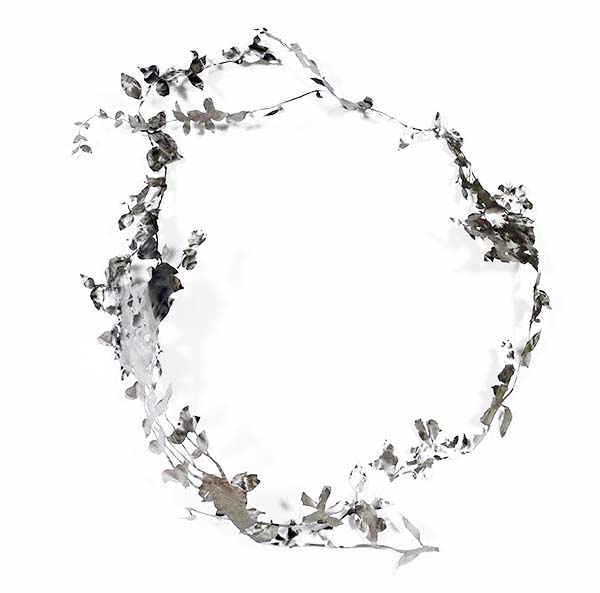Title Image: Revolution study (2014) Brushed stainless steel. 15x150x150cm.

In traditional Chinese papercutting the depiction of flora is by and large symbolic. Peony, for instance, is a symbol for longevity. In my contemporary craft practice the use of floral motifs may be categorised into the following: (a) depictions of introduced species to reference the integration of foreign entities or cultural practices, (b) depictions of emblematic flora to symbolise specific geographic locations and (c) the installation plastic flora to connote the unsustainability of our contemporary lifestyles. It is the colonialist nature of plants that makes them powerful allegorical devices in my compositions.
I am presently applying the floral motif of the jasmine in an artwork titled Revolution. Varieties of jasmine are classified as invasive in countries such as the United States, Australia and New Zealand. In Revolution, jasmine vines have been fashioned into barbed wire. The flower was imbued with significance in 2010 by Tunisian rebels in what became known as the Jasmine Revolution. Depictions of the flower were used as a call to arms. The jasmine became a symbol for democracy. Democracy is an aggressive ideology. I am interested in the colonist success of both this species of flora and the ideology it represents.
In 2005, I also used invasive flora a metaphor for the detriment caused to communities by the presence of alcohol. I juxtaposed the floral motifs onto beer packaging. The species used were each classified as ornamentals in urban areas of Australia and noxious weeds in the Australian Outback. This series was inspired by a trip to Yungaburra, a community south of Cairns in which alcohol was prohibited. At the time, I was undertaking a residency at the Centre of Contemporary Arts in Cairns.
Large plastic flowers reoccur in my arts practice. Like the compositions that use invasive species as allegory, these artworks explore the notion of sustainability. The material, plastic, is the introduced element. The environment is the Australian consumer market. I draw parallels between the colonist nature of plants and the strategies employed by multinational corporations. The use of the plastic connotes mass production. It also highlights an incongruous desire for the objects to possess a durability far beyond their usefulness. The beauty of a flower is in the brevity of its existence. A plastic one does not expire. It does accumulate damage and/or become displaced by newer domestic items. Landfill is the inevitable destiny for these non-biodegradable substitutes.